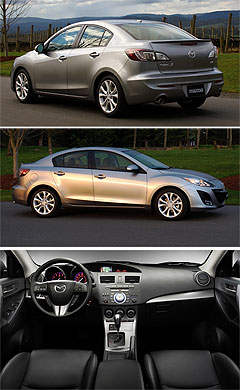Make / Model Search
Future models - Mazda - Mazda3LA show: Mazda's three-box debutAnticipation: The latest version of Australia's most popular privately purchased car will arrive here by the middle of 2009. Mazda chose the LA show for the first public unveiling of its seminal ‘3’ sedan20 Nov 2008 MORE details have emerged about Mazda’s global bestseller at this week’s Los Angeles Motor Show with the roll-out of the second-generation Mazda3 in four-door sedan guise. The Bologna motor show in Italy on December 3 will see the debut of the five-door hatchback version of the seventh front-wheel drive small car from the Hiroshima-based company. Slated for an Australian launch in the middle of 2009, the BL-series 3 uses an evolution of the current BK model’s advanced C1 small car architecture that is also shared with the Ford Focus and Volvo C30/S40/V50. This means the most popular privately purchased new car in Australia will continue to be underpinned by a front-wheel drive platform offering the lauded independently sprung multi-link rear suspension set-up matched by a MacPherson strut front end. Improved electro-hydraulic power-assisted rack-and-pinion steering has been devised, with revised mounting points for improved feel and reduced vibration. The wheelbase and width stay the same at 2640mm and 1755mm respectively, but the 15mm and 5mm increases in length and height respectively (to 4590mm and 1470mm) highlights the growth spurt this Japanese small car has seen compared to the current sedan. In the US, a choice of two twin-cam 16-valve four-cylinder petrol engines will be offered initially, with a 2.0-litre turbo-diesel following soon after. The 2.0-litre petrol unit offers 110kW of power at 6500rpm and 183Nm of torque at 4500rpm. These outputs are slightly up on the current 108kW/182Nm Australian-market unit. Bigger news is the introduction of a five-speed automatic transmission in place of the old four-speed unit, resulting in a 10 per cent improvement in highway fuel economy. A five-speed manual remains the standard item.  Meanwhile, the sporty old SP23 has been sidelined for the new SP25, using a variation of the 2.5-litre four-cylinder petrol engine found in the latest Mazda6. Meanwhile, the sporty old SP23 has been sidelined for the new SP25, using a variation of the 2.5-litre four-cylinder petrol engine found in the latest Mazda6.US output figures are 124kW at 6000rpm and 227Nm at 4000rpm, compared to 125kW/226Nm for the same engine in the Aussie ‘6’ and 115kW/203Nm for the outgoing 2.3-litre SP23. Again, the SP version will be offered with either a six-speed manual or five-speed automatic gearbox. So, evolution is the name of the game, with Mazda garnering research and development input from Europe and the US as well as Japan. Stylistically, the 3 espouses Mazda’s new global “family face” with a Peugeot 308-esque integrated grille/lower bumper air intake, and the front mudguards are clearly inspired by the company’s RX-8 performance coupe. However, the rest of the sedan seems very similar to the outgoing car in sharing a coupe-like profile, even though every body panel is new and visibly different under closer scrutiny. Messing with the existing winning design formula was not on the company’s agenda. Yet the 3’s aerodynamic qualities have been enhanced, promising decreased wind noise intrusion, while a stiffer and more rigid body promises to successfully tackle noise pathways – the current model’s biggest bugbear. “Re-engineered monocoque joints and increased metal gauges in key areas help diminish the transmission of road and powertrain noise into the passenger cabin,” claims Mazda. “Suspension anchor points are more substantial to provide the solid foundation needed to absorb steering and suspension forces. In addition to welded attachments, suspension towers are bonded to the surrounding unibody areas with structural adhesives.” Mazda should also be applauded for engineering a body-in-white that weighs virtually no more than the older, smaller vehicle despite being significantly beefier. And recyclability levels rise from 80 to 90 per cent. More change can be found inside, thanks to a completely redesigned dashboard that majors on Mazda’s human-machine interface theme – revealed, for instance, in the way key switches and knobs are on the same reach level as the steering wheel and gear shifter. Navigation, trip and audio displays are positioned on the upper-edge of the fascia for easier viewing, while larger, wider and shapelier seating has been incorporated for greater comfort and support. More attention to detail has been paid, with soft-touch cabin trim surfaces introduced. Also new to the series will be the availability of dual-zone climate control, active bi-Xenon high intensity discharge headlights with cornering capability and an eight-way powered driver’s seat, while standard-issue DSC stability control, six airbags, active front head restraints and improved braking (vented discs up front and solid discs out back) are also part of the new model’s repertoire. Since its debut at the 2003 Frankfurt motor show, the Mazda3 has been a consistent success for the brand, garnering over 1.8 million sales worldwide, including more than 150,000 in Australia. Read more:Sydney show: Mazda3 makes global debutRotary won’t die but current Mazda3 a hard act to follow New Mazda3 stands aside All motor showMotor industry news |
Click to shareAll motor showMotor industry news |

 Alfa Romeo
Alfa Romeo Abarth
Abarth Audi
Audi Aston Martin
Aston Martin BMW
BMW Bentley
Bentley Ferrari
Ferrari Chevrolet
Chevrolet Ford
Ford Fiat
Fiat GWM
GWM Foton
Foton Hyundai
Hyundai Honda
Honda Jaguar
Jaguar Isuzu
Isuzu Kia
Kia Jeep
Jeep Land Rover
Land Rover Lamborghini
Lamborghini Maserati
Maserati Lexus
Lexus McLaren
McLaren Mazda
Mazda Mercedes-Benz
Mercedes-Benz Mitsubishi
Mitsubishi Mini
Mini Peugeot
Peugeot Nissan
Nissan Ram
Ram Porsche
Porsche Rolls-Royce
Rolls-Royce Smart
Smart Skoda
Skoda Suzuki
Suzuki Subaru
Subaru Toyota
Toyota Tesla
Tesla Volvo
Volvo Zeekr
Zeekr







Facebook Twitter Instagram